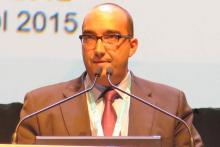User login
VIENNA – The mTOR inhibitor everolimus cut the risk of progression or death by 52% for patients with advanced, progressive, nonfunctional lung or gastrointestinal neuroendocrine tumors in RADIANT-4.
Median progression-free survival (PFS) by central review was 11.0 months with everolimus vs. 3.9 months with placebo (hazard ratio, 0.48; P less than .00001).
The robust benefit was confirmed in investigator assessment (median PFS, 14.0 months vs. 5.5 months; HR, 0.39; P less than .00001).
“Everolimus is the first targeted agent to show robust antitumor activity with acceptable toxicity across a broad spectrum of neuroendocrine tumors, including those arising from the pancreas, lung, and gastrointestinal tract,” Dr. James Yao, chair of gastrointestinal medical oncology at the University of Texas MD Anderson Cancer Center, Houston, said in a presidential session at the European Society for Medical Oncology congress.
The resultsare particularly important for patients with lung neuroendocrine tumors (NETs) because there is currently no approved treatment for such cases.
Everolimus, a mammalian target of rapamycin (mTOR) inhibitor, is already an approved standard of care in pancreatic NETs, based on the results of RADIANT-3.
Discussant Dr. Enrique Grande of Ram<scaps>ó</scaps>n y Cajal University Hospital in Madrid, said, “RADIANT-1, -2, -3, and now -4 results are all consistent and support the use of everolimus in grade 1 and 2 disseminated and progressive neuroendocrine regardless of primary tumor origin.”
That said, he observed that the median 11-month progression-free survival with everolimus is not superior to the 14.3-month PFS offered by the somatostatin analogue octreotide LAR in midgut NETs in PROMID, the 16.4-month PFS with everolimus plus octreotide LAR in RADIANT-2 in a cohort that included 15% lung NETs, or the 16.6-month PFS with bevacizumab (Avastin) plus octreotide LAR in a mixed cohort of NETs in SWOG S0518.
“Despite the encouraging activity favoring everolimus, we do not have the full picture yet,” Dr. Grande said. “Should everolimus be pushed after somatostatin analogue failure? If so, and this is something that most of the people here are doing, is single-agent everolimus better than maintenance of somatostatin analogues plus adding on everolimus?
“This is not like other tumor types, in which we are talking about first-line, second-line, third-line. We don’t have these things here. We have an unknown line of treatment.”
RADIANT-4 enrolled 302 patients with a median age of 63 years and randomized them in 2:1 ratio to everolimus 10 mg/day until disease progression or intolerable toxicity or to placebo. Patients were stratified by prior somatostatin analogue (SSA) treatment (yes vs. no), tumor origin (stratum A vs. stratum B), and WHO performance status (0 vs. 1). Stratum A (better prognosis) comprised appendix, caecum, jejunum, ileum, duodenum, and NET of unknown primary, while stratum B (worse prognosis) comprised lung, stomach, rectum, and colon except caecum. Crossover to open-label everolimus after progression in the placebo arm was not allowed prior to the primary analysis.
The most common primary tumor sites were lung and ileum in both the everolimus (31% and 23%) and placebo (28% and 25%) groups. In the everolimus group, 53% had prior SSA therapy, 59% surgery, 26% chemotherapy, and 22% radiotherapy. In the placebo group, the percentages were 56%, 72%, 24%, and 20%.
Overall, 64% of patients receiving everolimus had some tumor shrinkage vs. 26% receiving placebo, Dr. Yao said. The overall response rate, including complete and partial responses, was 2% vs. 1%. The disease control rate, which also included stable disease, was 82.4% vs. 65%.
The median duration of treatment was 40.4 weeks with everolimus and 19.6 weeks with placebo.
A consistent PFS benefit was seen with everolimus regardless of stratification factors, age, sex, race, tumor grade, prior therapy, and baseline chromogranin A or neuron-specific enolase status, he said.
Benefits also were seen across hepatic tumor load. This included an 82% reduction in progression with everolimus (HR, 0.18) among those with heavy liver tumor burden (greater than 25%), “a group of patients that really needs treatment,” Dr. Yao said.
The PFS benefit also was consistent across primary tumor site: lung (HR, 0.50), GI (HR, 0.56), and NET of unknown primary (HR, 0.60).
The first interim overall analysis showed a 36% reduction in the risk of death with everolimus (HR, 0.64; P = .037), but this was not statistically significant based on the prespecified P value boundary for significance of 0.0002, Dr. Yao said. There were 41 deaths in the everolimus arm and 28 in the placebo arm, of which 3.5% vs. 3.1% were on-treatment deaths. The next interim analysis is expected in 2016.
The safety profile was consistent with the known profile of everolimus, he said. In the everolimus arm, the most common drug-related adverse events of any grade were stomatitis (63%), diarrhea (31%), fatigue (31%), and infections (29%). Common grade 3/4 events were stomatitis (9%), diarrhea (7%), infections (7%), and fatigue (3%).
Dr. Peter Naredi, scientific cochair of the congress, commented that this year’s meeting is particularly exciting for clinicians treating patients with neuroendocrine tumors because two trials, RADIANT-4 and NETTER-1 both show positive results.
On Twitter @pwendl
VIENNA – The mTOR inhibitor everolimus cut the risk of progression or death by 52% for patients with advanced, progressive, nonfunctional lung or gastrointestinal neuroendocrine tumors in RADIANT-4.
Median progression-free survival (PFS) by central review was 11.0 months with everolimus vs. 3.9 months with placebo (hazard ratio, 0.48; P less than .00001).
The robust benefit was confirmed in investigator assessment (median PFS, 14.0 months vs. 5.5 months; HR, 0.39; P less than .00001).
“Everolimus is the first targeted agent to show robust antitumor activity with acceptable toxicity across a broad spectrum of neuroendocrine tumors, including those arising from the pancreas, lung, and gastrointestinal tract,” Dr. James Yao, chair of gastrointestinal medical oncology at the University of Texas MD Anderson Cancer Center, Houston, said in a presidential session at the European Society for Medical Oncology congress.
The resultsare particularly important for patients with lung neuroendocrine tumors (NETs) because there is currently no approved treatment for such cases.
Everolimus, a mammalian target of rapamycin (mTOR) inhibitor, is already an approved standard of care in pancreatic NETs, based on the results of RADIANT-3.
Discussant Dr. Enrique Grande of Ram<scaps>ó</scaps>n y Cajal University Hospital in Madrid, said, “RADIANT-1, -2, -3, and now -4 results are all consistent and support the use of everolimus in grade 1 and 2 disseminated and progressive neuroendocrine regardless of primary tumor origin.”
That said, he observed that the median 11-month progression-free survival with everolimus is not superior to the 14.3-month PFS offered by the somatostatin analogue octreotide LAR in midgut NETs in PROMID, the 16.4-month PFS with everolimus plus octreotide LAR in RADIANT-2 in a cohort that included 15% lung NETs, or the 16.6-month PFS with bevacizumab (Avastin) plus octreotide LAR in a mixed cohort of NETs in SWOG S0518.
“Despite the encouraging activity favoring everolimus, we do not have the full picture yet,” Dr. Grande said. “Should everolimus be pushed after somatostatin analogue failure? If so, and this is something that most of the people here are doing, is single-agent everolimus better than maintenance of somatostatin analogues plus adding on everolimus?
“This is not like other tumor types, in which we are talking about first-line, second-line, third-line. We don’t have these things here. We have an unknown line of treatment.”
RADIANT-4 enrolled 302 patients with a median age of 63 years and randomized them in 2:1 ratio to everolimus 10 mg/day until disease progression or intolerable toxicity or to placebo. Patients were stratified by prior somatostatin analogue (SSA) treatment (yes vs. no), tumor origin (stratum A vs. stratum B), and WHO performance status (0 vs. 1). Stratum A (better prognosis) comprised appendix, caecum, jejunum, ileum, duodenum, and NET of unknown primary, while stratum B (worse prognosis) comprised lung, stomach, rectum, and colon except caecum. Crossover to open-label everolimus after progression in the placebo arm was not allowed prior to the primary analysis.
The most common primary tumor sites were lung and ileum in both the everolimus (31% and 23%) and placebo (28% and 25%) groups. In the everolimus group, 53% had prior SSA therapy, 59% surgery, 26% chemotherapy, and 22% radiotherapy. In the placebo group, the percentages were 56%, 72%, 24%, and 20%.
Overall, 64% of patients receiving everolimus had some tumor shrinkage vs. 26% receiving placebo, Dr. Yao said. The overall response rate, including complete and partial responses, was 2% vs. 1%. The disease control rate, which also included stable disease, was 82.4% vs. 65%.
The median duration of treatment was 40.4 weeks with everolimus and 19.6 weeks with placebo.
A consistent PFS benefit was seen with everolimus regardless of stratification factors, age, sex, race, tumor grade, prior therapy, and baseline chromogranin A or neuron-specific enolase status, he said.
Benefits also were seen across hepatic tumor load. This included an 82% reduction in progression with everolimus (HR, 0.18) among those with heavy liver tumor burden (greater than 25%), “a group of patients that really needs treatment,” Dr. Yao said.
The PFS benefit also was consistent across primary tumor site: lung (HR, 0.50), GI (HR, 0.56), and NET of unknown primary (HR, 0.60).
The first interim overall analysis showed a 36% reduction in the risk of death with everolimus (HR, 0.64; P = .037), but this was not statistically significant based on the prespecified P value boundary for significance of 0.0002, Dr. Yao said. There were 41 deaths in the everolimus arm and 28 in the placebo arm, of which 3.5% vs. 3.1% were on-treatment deaths. The next interim analysis is expected in 2016.
The safety profile was consistent with the known profile of everolimus, he said. In the everolimus arm, the most common drug-related adverse events of any grade were stomatitis (63%), diarrhea (31%), fatigue (31%), and infections (29%). Common grade 3/4 events were stomatitis (9%), diarrhea (7%), infections (7%), and fatigue (3%).
Dr. Peter Naredi, scientific cochair of the congress, commented that this year’s meeting is particularly exciting for clinicians treating patients with neuroendocrine tumors because two trials, RADIANT-4 and NETTER-1 both show positive results.
On Twitter @pwendl
VIENNA – The mTOR inhibitor everolimus cut the risk of progression or death by 52% for patients with advanced, progressive, nonfunctional lung or gastrointestinal neuroendocrine tumors in RADIANT-4.
Median progression-free survival (PFS) by central review was 11.0 months with everolimus vs. 3.9 months with placebo (hazard ratio, 0.48; P less than .00001).
The robust benefit was confirmed in investigator assessment (median PFS, 14.0 months vs. 5.5 months; HR, 0.39; P less than .00001).
“Everolimus is the first targeted agent to show robust antitumor activity with acceptable toxicity across a broad spectrum of neuroendocrine tumors, including those arising from the pancreas, lung, and gastrointestinal tract,” Dr. James Yao, chair of gastrointestinal medical oncology at the University of Texas MD Anderson Cancer Center, Houston, said in a presidential session at the European Society for Medical Oncology congress.
The resultsare particularly important for patients with lung neuroendocrine tumors (NETs) because there is currently no approved treatment for such cases.
Everolimus, a mammalian target of rapamycin (mTOR) inhibitor, is already an approved standard of care in pancreatic NETs, based on the results of RADIANT-3.
Discussant Dr. Enrique Grande of Ram<scaps>ó</scaps>n y Cajal University Hospital in Madrid, said, “RADIANT-1, -2, -3, and now -4 results are all consistent and support the use of everolimus in grade 1 and 2 disseminated and progressive neuroendocrine regardless of primary tumor origin.”
That said, he observed that the median 11-month progression-free survival with everolimus is not superior to the 14.3-month PFS offered by the somatostatin analogue octreotide LAR in midgut NETs in PROMID, the 16.4-month PFS with everolimus plus octreotide LAR in RADIANT-2 in a cohort that included 15% lung NETs, or the 16.6-month PFS with bevacizumab (Avastin) plus octreotide LAR in a mixed cohort of NETs in SWOG S0518.
“Despite the encouraging activity favoring everolimus, we do not have the full picture yet,” Dr. Grande said. “Should everolimus be pushed after somatostatin analogue failure? If so, and this is something that most of the people here are doing, is single-agent everolimus better than maintenance of somatostatin analogues plus adding on everolimus?
“This is not like other tumor types, in which we are talking about first-line, second-line, third-line. We don’t have these things here. We have an unknown line of treatment.”
RADIANT-4 enrolled 302 patients with a median age of 63 years and randomized them in 2:1 ratio to everolimus 10 mg/day until disease progression or intolerable toxicity or to placebo. Patients were stratified by prior somatostatin analogue (SSA) treatment (yes vs. no), tumor origin (stratum A vs. stratum B), and WHO performance status (0 vs. 1). Stratum A (better prognosis) comprised appendix, caecum, jejunum, ileum, duodenum, and NET of unknown primary, while stratum B (worse prognosis) comprised lung, stomach, rectum, and colon except caecum. Crossover to open-label everolimus after progression in the placebo arm was not allowed prior to the primary analysis.
The most common primary tumor sites were lung and ileum in both the everolimus (31% and 23%) and placebo (28% and 25%) groups. In the everolimus group, 53% had prior SSA therapy, 59% surgery, 26% chemotherapy, and 22% radiotherapy. In the placebo group, the percentages were 56%, 72%, 24%, and 20%.
Overall, 64% of patients receiving everolimus had some tumor shrinkage vs. 26% receiving placebo, Dr. Yao said. The overall response rate, including complete and partial responses, was 2% vs. 1%. The disease control rate, which also included stable disease, was 82.4% vs. 65%.
The median duration of treatment was 40.4 weeks with everolimus and 19.6 weeks with placebo.
A consistent PFS benefit was seen with everolimus regardless of stratification factors, age, sex, race, tumor grade, prior therapy, and baseline chromogranin A or neuron-specific enolase status, he said.
Benefits also were seen across hepatic tumor load. This included an 82% reduction in progression with everolimus (HR, 0.18) among those with heavy liver tumor burden (greater than 25%), “a group of patients that really needs treatment,” Dr. Yao said.
The PFS benefit also was consistent across primary tumor site: lung (HR, 0.50), GI (HR, 0.56), and NET of unknown primary (HR, 0.60).
The first interim overall analysis showed a 36% reduction in the risk of death with everolimus (HR, 0.64; P = .037), but this was not statistically significant based on the prespecified P value boundary for significance of 0.0002, Dr. Yao said. There were 41 deaths in the everolimus arm and 28 in the placebo arm, of which 3.5% vs. 3.1% were on-treatment deaths. The next interim analysis is expected in 2016.
The safety profile was consistent with the known profile of everolimus, he said. In the everolimus arm, the most common drug-related adverse events of any grade were stomatitis (63%), diarrhea (31%), fatigue (31%), and infections (29%). Common grade 3/4 events were stomatitis (9%), diarrhea (7%), infections (7%), and fatigue (3%).
Dr. Peter Naredi, scientific cochair of the congress, commented that this year’s meeting is particularly exciting for clinicians treating patients with neuroendocrine tumors because two trials, RADIANT-4 and NETTER-1 both show positive results.
On Twitter @pwendl
AT THE EUROPEAN CANCER CONGRESS 2015
Key clinical point: Everolimus significantly delays tumor growth in advanced lung and gastrointestinal neuroendocrine tumors.
Major finding: Median progression-free survival was 11 months for everolimus vs. 3.9 months for placebo (hazard ratio, 0.39; P < .00001).
Data source: Double-blind phase III study in 302 patients with advanced, progressive lung and GI neuroendocrine tumors.
Disclosures: Novartis sponsored the study. Dr. Yao reported serving as a consultant to and receiving research funding from Novartis.


